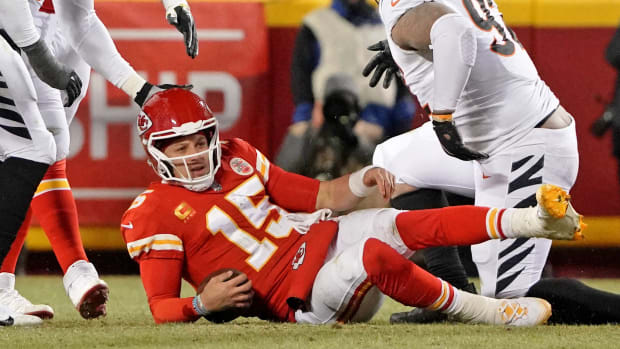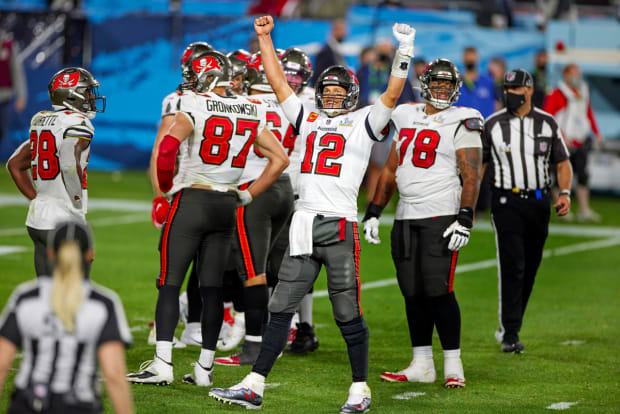What you’re reading is the product of eight years of trying to figure out the best way to use all of the information, anecdotes, trash talk, insight, nonsense, and reporting that goes into my favorite story of the year: the Sports Illustrated Super Bowl cover story. I used to call this thing my baby, but now that I have two of those for real, I’d like to think I love them more—but not by much.
In those eight seasons, I’ve written about Malcolm Butler’s interception, Von Miller’s greatness, Julian Edelman’s improbable catch, Nick Foles’s transition to Philadelphia sports legend, the Patriots’ dynasty to end all dynasties, Mahomes’s first title, Brady’s seventh ring and the Rams’ epic journey. I’ve talked my way into Brady’s private after-party, plunged into the Pacific Ocean with Rams GM Les Snead, and watched Patriots owner Robert Kraft and a mink-coat-wearing P. Diddy sit together listening to Lionel Richie—the real thing, not a recording—belt out “All Night Long.”
I’ve always worked with another writer, from Joan Niesen to Ben Baskin to Jenny Vrentas to, now, Conor Orr. They’re all excellent, and all critical to the process. They help conduct, in a typical year, more than 50 interviews—some years it’s more than 100. We set out to tell the best story of a team’s season, and we’ve talked to comedians (Lenny Clarke); actors (Will Ferrell, Dennis Leary, Jenny McCarthy); musicians (Macklemore, Meek Mill, Migos, Kenny Chesney); historians; documentarians; authors; confidants; superfans; Hall of Famers; soccer luminaries; basketball executives; and even Bill Nye (as in “The Science Guy”).
The problem we’ve never solved is this: My laptop contains thousands upon thousands of pages of original reporting, much of it new or deeper than what’s out there. But we write the story overnight—word counts have ranged from 4,500 to 8,500—and there’s just never enough room to come anywhere close to using everything we uncover. Hence the newsletter now sitting in your inbox.
Please send all ideas/qualms/sources our way (nfl@si.com). Starting Monday, we’ll publish everyday right up until Super Bowl Sunday. Today, we wanted to give you a taste of what to expect …

Denny Medley/USA TODAY Sports
Like the rest of a nation of football addicts, Jack Youngblood watched Patrick Mahomes play on a high ankle sprain last Sunday. Same as he watched Jalen Hurts return early after spraining his throwing shoulder. In both instances, but in the case of Mahomes and one fourth-quarter scramble specifically, Youngblood recognized the guts involved.
He watched Mahomes take off, running when he could not run, or at least should not run. Mahomes reached the sideline, only to be lightly shoved while already out of bounds. The improvisation and the fortuitous penalty pushed the Chiefs into field goal range for the kick that brought them back to the Super Bowl. Youngblood saw that sequence and saw himself.
Youngblood, the 73-year-old Hall of Famer, is thinking back to late December 1979, when, as a Rams defensive end, he earned his place in a rare fraternity, the one that Mahomes joined last week. Call it Injured Athletic Greatness. Or, as Youngblood explains, the moment when the body feels pain but the athlete, in some ways, leaves his own body. “Your mind blocks it out. It reduces the pain to where you can run, like [Mahomes] did, briefly. But then you saw him slow down. He started hobbling worse. When he’s running, he’s having an out-of-body experience.”
Youngblood laughs. He knows how that sounds. But he also knows the mind is a complex and infinitely mystical place. Running on a bum right ankle that would have sidelined most players is like being confronted by someone holding a gun, Youngblood says. There’s instant focus. Heightened adrenaline. The ability to do what should not even be attempted. “It’s not teachable,” Youngblood says. “It’s something you just have to ignore.”
He would know. In the annals of Injured Athletic Greatness, Youngblood ranks among the most famous examples in sports history. Think Willis Reed hobbling back onto the court, Michael Jordan dominating with the flu or Kobe Bryant taking free throws with a torn Achilles. Think Youngblood, who led the NFL in sacks (18) in 1979, pushing the Rams into the postseason, where the Cowboys awaited.
Youngblood remembers being caught from behind on a pass rush. While wading past an offensive tackle, the nearest guard hit him and fell down on his left foot, which caught in the turf as both men twisted. The result: a broken left tibia. But Youngblood didn’t find that out until halftime, when team doctor Clarence Shields showed him an X-ray. “You got a broken leg,” Youngblood remembers the doc saying. Shields pointed. “See, right here, right above the ankle.”
Sitting atop the training table, Youngblood could see his injured limb beginning to swell up.
“You can’t do this,” Shields said. “You can’t keep running on a broken leg.”
“Tape it up, dammit,” Youngblood responded.
Shields admitted he wasn’t the kind of doctor who knew how to “tape up” a broken leg. Someone else did. Youngblood took a pain-numbing injection, then jogged back onto the field, sealing his team’s victory with a sack in the final minutes of the fourth quarter. The next week, he helped the Rams shut out the Buccaneers to reach the Super Bowl. He played again. His Rams lost to the Steelers, but he proved things like his toughness and how much his teammates mattered to him. So did football; he even played in the Pro Bowl, although “not that well,” he says.
Sometimes, Youngblood says, he looks back and considers whether he made a series of poor decisions. “No,” he says. “That’s not what it’s about. You’re there to help your team win. It’s that simple. Just breathe before the ball snaps. Give them a reason to play even harder.”
Mahomes did. His teammates said so in the aftermath. Youngblood watched Mahomes in the divisional round against Jacksonville, right after the injury, arguing with trainers to try to get back on the field. How many players in this era would do the same? he asks. His answer: very few. Because of that and because of the stakes involved, Youngblood says Mahomes didn’t simply join their odd fraternity. “He’s at the top,” Youngblood says. “My wife loves him. She thinks he’s her boyfriend! I just thought to myself: He’s one of us.”
THEN TO NOW:
This is from Clark Hunt, in an interview conducted after the Chiefs topped the 49ers in Super Bowl LIV and before they played (and lost) to the Bucs in Super Bowl LV. He’s talking about Brett Veach, who remains Kansas City’s chief architect.
“It’s easy to overlook Brett, but the job that he has done in his three and a half years as the general manager cannot be overstated. Of course, everybody knows the story about him being the catalyst for the team drafting Patrick, even when he wasn’t [GM]. And that certainly was his first huge imprint on the Super Bowl teams we have today.
“Since he has become GM, he has done a masterful job not only in the draft, where we’ve picked up a lot of solid contributors through all the rounds. Then look at the job he did in free agency [before the 2021 season] when he brought in Tyrann [Mathieu]. And the job he did in keeping the group together, re-signing Patrick and Chris Jones and extending [Travis] Kelce.
“I told him the other day: Unfortunately, it doesn’t look like you will win [the NFL’s General Manager of the Year award]. But we all know where the best GM in the league resides. And that’s in Arrowhead Stadium.”
The sentiment still applies. Veach is criminally underrated, both as one of the league’s best executives and for his influence on the Chiefs. Proof: the 2022 season.

Simon Bruty/Sports Illustrated
ON BACKGROUND:
I spoke to about 10 sources about Tom Brady’s sudden-but-not-unexpected retirement Wednesday. Some are close to Brady; others, less so. But none expect that he will play for an NFL team next season. It’s always possible, of course. And yet, it seems far less likely than it did at this time last year.
QUOTE WITHOUT CONTEXT:
“I never met one I didn’t like.” – Andy Reid
CONTEXT:
He was talking about cheesesteaks.
ELSEWHERE ON THE MMQB:
• In Search of Balance, Tom Brady Finally Saw Peace in Retirement
• QB Carousel Possibilities for Rodgers, Garoppolo and Others
• Jimmy Traina Answers Your Questions on the Brady-Olsen-Fox Situation
• Donna Kelce on Her Super Bowl Sons
• Why Neutral-Site Conference Championships Could Be Deeply Unpopular
• DeMeco Ryans and an Emerging Trend in Coach Hiring



















